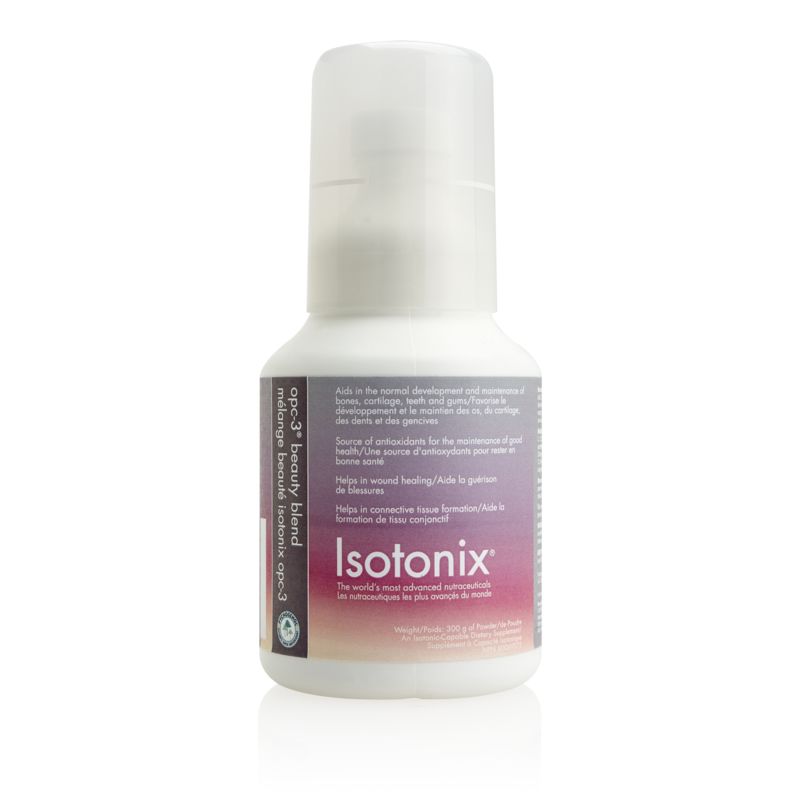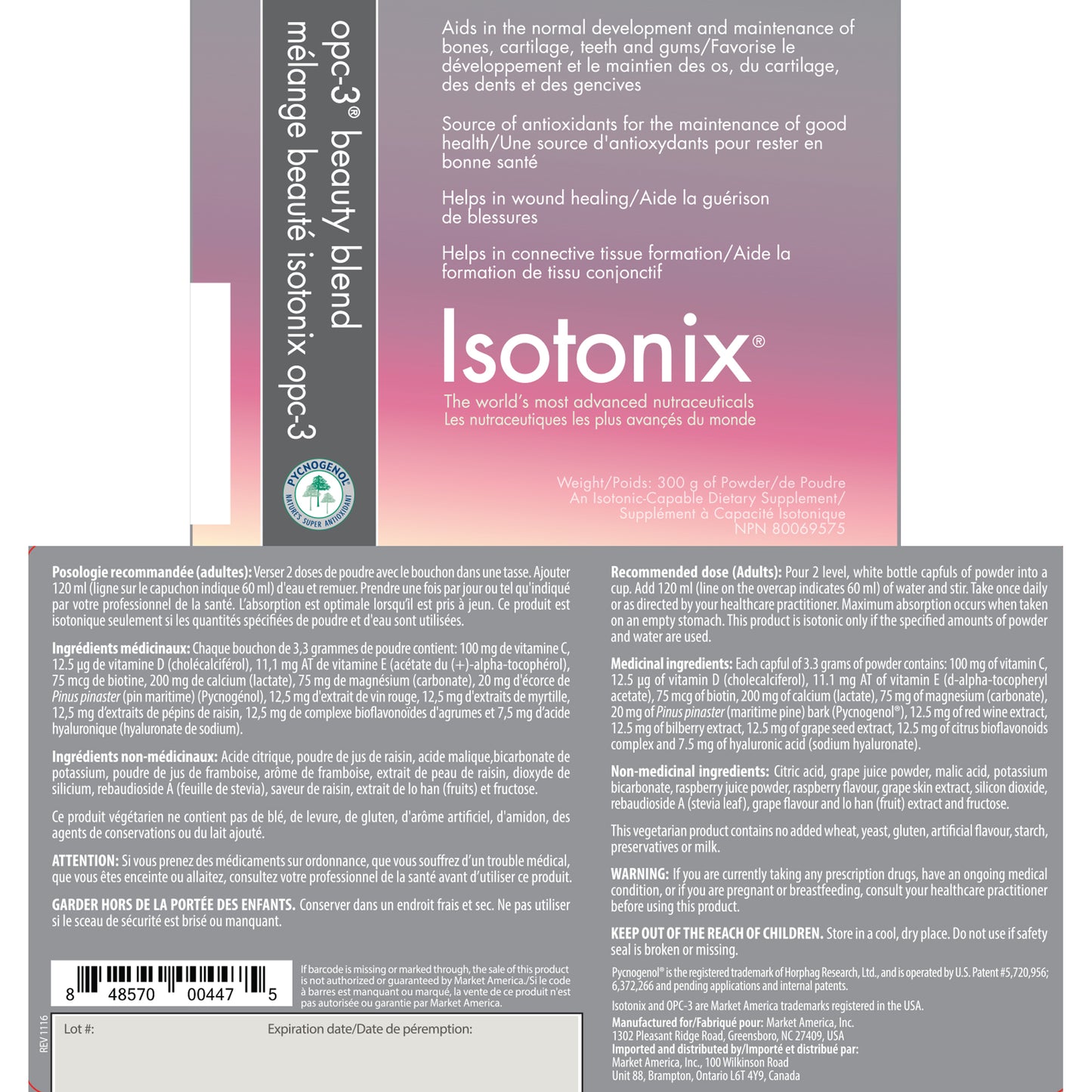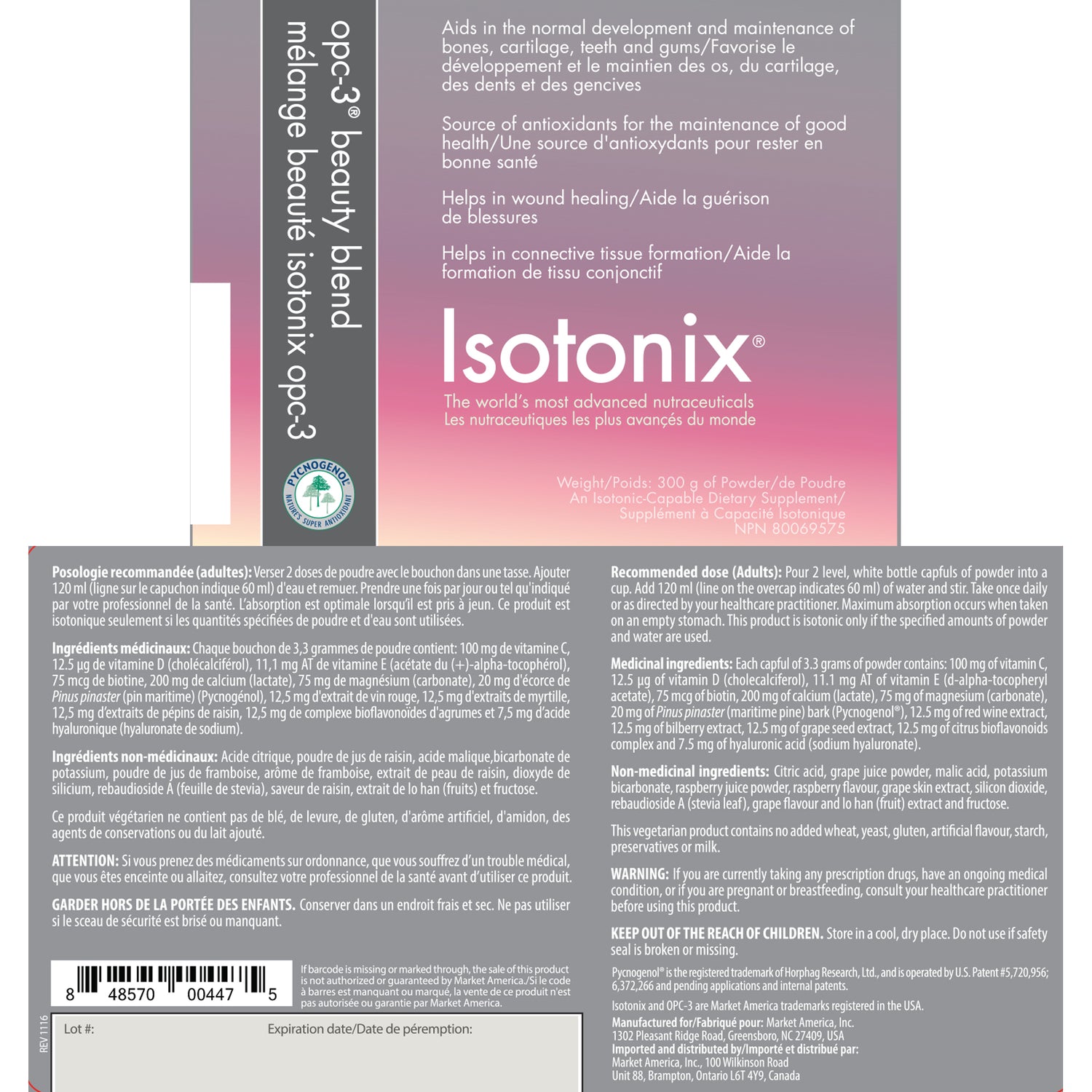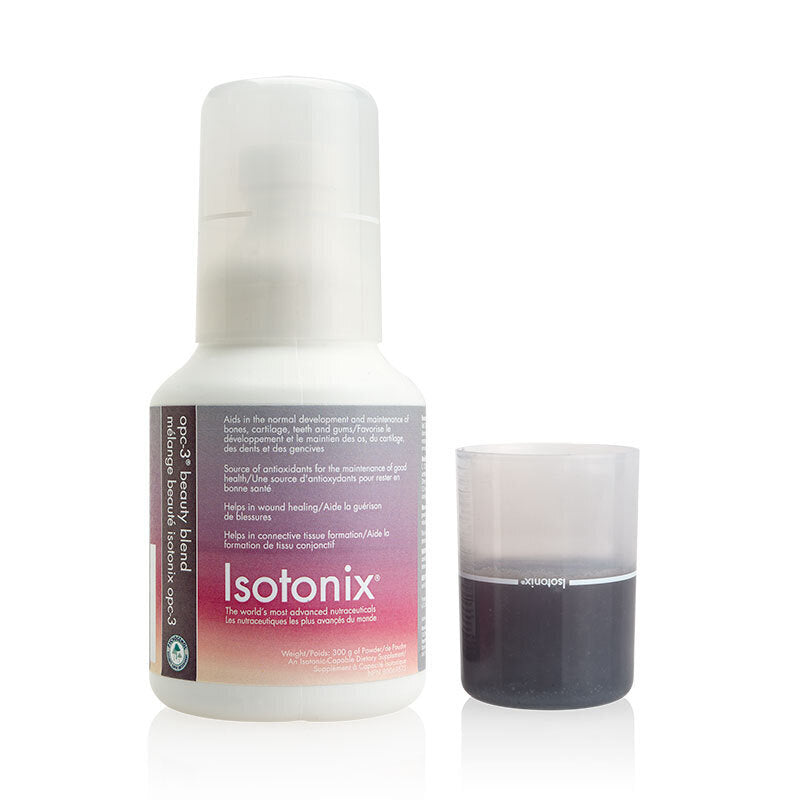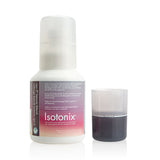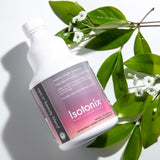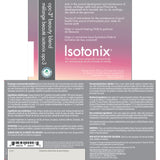Isotonix OPC-3® Beauty Blend
Market America
Isotonix OPC-3® Beauty Blend
SKU-C13997
45 servings
Couldn't load pickup availability
Similar Categories
Primary Benefits of Isotonix OPC-3® Beauty Blend
One of our most advanced beauty-care supplements.
- Contains key plant-based ingredients found in our top supplement Isotonix OPC-3 which are Pycnogenol®, red wine extract, bilberry extract, grape seed extract and citrus bioflavonoids complex
- Also contains key vitamins, minerals, and ingredients like vitamin C, vitamin D, vitamin E, biotin, calcium, magnesium, and hyaluronic acid
- Source of antioxidants for the maintenance of good health
- Helps in wound healing
- Helps in connective tissue formation
- Aids in the normal development and maintenance of bones, cartilage, teeth and gums
- Superior delivery of Isotonix/ An isotonic-capable dietary supplement
- Suitable for vegetarians
- Product contains no added wheat, yeast, gluten, artificial flavour, starch, preservatives or milk.
Isotonix OPC-3® Beauty Blend is a superior beauty health supplement, containing all of the same active ingredients found in our top antioxidant supplement, Isotonix OPC-3 plus extra essential ingredients for holistic beauty health. The nutritional supplement powder Isotonix OPC-3 Beauty Blend takes an inside-out approach to promote the health of your body and skin. This Isotonix nutritional supplement powder is one of the most advanced beauty supplements on the market. Isotonix OPC-3 Beauty Blend is specially formulated to replenish vitamins and minerals that are known to be essential for the health of your skin, while also providing the skin and body with a source of antioxidants to protect against free radicals. This product also helps with tissue formation and the normal development and maintenance of bones, cartilage, teeth and gums to keep your smile healthy and bright.
The formula for Isotonix OPC-3 Beauty Blend includes some of the most powerful bioflavonoids currently known to research scientists. These bioflavonoids are scientifically termed oligomeric proanthocyanidins, commonly abbreviated OPCs. Studies have shown OPCs to be up to 20 times more powerful than vitamin C and50 times more powerful than vitamin E in neutralizing free radicals. The best-researched OPCs are from grape seed, red wine, grape skin, bilberries, citrus fruit and Pycnogenol®†. The combination of these powerful OPCs is unique to Isotonix OPC-3 and Isotonix OPC-3 Beauty Blend. Each is a powerful free-radical scavenger that works to help keep you healthy and beautiful. These antioxidants are coupled with specific vitamins, minerals and hyaluronic acid for a comprehensive and unique beauty formula.
†Pycnogenol® is a registered trademark of Horphag Research, Ltd.
Key Ingredients
Grape Seed Extract
Grape seed extract is typically extracted from the seeds of red grapes (instead of white), which have a high content of compounds known as oligomeric proanthocyanidins. Grape seed extract is extremely rich in polyphenols, a compound high in antioxidants. Grape seed extract has even been found to promote healthy cholesterol levels.
Red Wine Extract
Red wine extract contains rich beneficial active ingredients. This extract is found in grape vines, roots, seeds and stalk, with its highest concentration in the skins. In the late 1990s, scientists took note of a phenomenon among the French. There were very low rates of heart disease in the provinces where residents consistently ate high fat foods and drank red wine. Scientists concluded that the protective properties of red wine have helped the French maintain heart health for years and subsequent scientific studies have further proven the fact that the OPCs found in red wine are greatly beneficial to maintain general well-being.
Pine Bark Extract (Pycnogenol®)
Pycnogenol® is a natural plant extract from the bark of the maritime pine tree, which grows exclusively along the coast of southwest France in Les Landes de Gascogne. This unspoiled and natural forest environment is the unique source of pine bark. Pycnogenol® represents a natural combination of genetically programmed constant proportions of procyanidins, bioflavonoids and organic acids. Pine bark extract (Pycnogenol®) is a powerful antioxidant. As one of the most potent natural scavenger of free radicals, Pycnogenol® combats many aggressive free radicals before they cause oxidative stress to vital organs. It has super-antioxidant capabilities.
Bilberry Extract
Bilberry extract is derived from the leaves and berry-like fruit of a common European shrub closely related to the blueberry. Extracts of the ripe berry are known to contain flavonoid pigments known as anthocyanins, powerful antioxidants. Scientific studies confirm that bilberry extract supports healthy vision and venous circulation. Bilberry extract helps maintain healthy circulation by strengthening capillaries, arteries and veins.
Citrus Extract (Bioflavonoids)
Bioflavonoids are found in certain plants to act as light filters protecting the delicate DNA chains and other important macromolecules by absorbing ultraviolet radiation. They have been found to promote cardiovascular health, help maintain healthy circulation by strengthening capillaries, arteries, and veins and demonstrate anti-inflammatory activity.
Hyaluronic Acid (Sodium Hyaluronate)
Hyaluronic acid or hyaluronate is a glycosaminoglycan distributed widely throughout connective, epithelial and neural tissues, and is commonly used in skin care products. It is one of the main constituents of the extracellular matrix and promotes healthy cell proliferation and migration. Plentiful in extracellular matrices, hyaluronic acid supports healthy tissue hydrodynamics, movement and production of cells, and promotes a number of cell surface receptor interactions. Because hylauronic acid is found mostly in the skin, cartilage, it supports joint health. It has also been suggested that hyaluronic acid promotes healthy cartilage cells. Hyaluronic acid may also be used to promote healing of minor tissue injuries.
Vitamin C (Ascorbic Acid)
It is a water soluble vitamin which the human body cannot synthesize and therefore we have to get it from the foods we eat, like citrus fruits, or through supplementation. While the Recommended Daily Intake for Vitamin C is 60mg, many individuals, such as those who smoke, need more vitamin C and can benefit from taking more than the minimum necessary. Studies suggest that taking 500 mg – 1000 mg of vitamin C daily can be beneficial for immune health and provide many other benefits. Around 90 percent of vitamin C in the typical diet comes from fresh fruits and vegetables. Peppers — sweet green and red peppers and hot red and green chili peppers — are especially rich in vitamin C. Other good sources include citrus fruits and juices, brussel sprouts, cauliflower, cabbage, kale, collards, mustard greens, broccoli, spinach and strawberries. It is important to note that cooking destroys vitamin C activity. Vitamin C, justifiably so, has become the world’s most popular vitamin. The reasoning behind this vitamin’s grand reputation is at once multi-faceted as well as amazing. Ascorbic acid is best known for its antioxidant properties and it may be the most important water-soluble antioxidant in the body. The capacity of vitamin C to support the immune system seems to be common knowledge. some studies also support vitamin C supplementation will help to maintain healthy vision and skin. Vitamin C plays a crucial role in maintaining healthy connective tissues including collagen, elastin, fibronectin, proteoglycans, bone matrix and elastin-associated fibrillin. Also, a lack of vitamin C can cause general fatigue. vitamin C helps in moderating healthy iron absorption, transport and storage. It promotes the normal intestinal absorption of iron.
Vitamin D3 (Cholecalciferol)
Vitamin D is a fat-soluble vitamin that is found in some foods and produced when sunlight strikes the skin and activates vitamin D synthesis. Vitamin D promotes the efficient intestinal absorption of calcium, primarily in the duodenum and jejunum by supporting the synthesis of calcium-binding proteins to promote normal calcium absorption and retention. Vitamin D also promotes the normal formation of bone and normal bone growth and bone remodeling by osteoblasts and osteoclasts. Vitamin D deficiency can be caused by factors such as lack of exposure to sunlight, reduced skin synthesis of vitamin D, lower dietary intake, impaired intestinal absorption and reduced metabolism to active forms of vitamin D by the kidneys, all of which increase with aging. Deficiency has been linked to numerous health concerns, and insufficient levels of this vitamin are associated with frail bones and muscle weakness.
Vitamin E Acetate (d-Alpha-Tocopheryl-Acetate)
The most valuable sources of dietary vitamin E include vegetable oils, margarine, nuts, seeds, avocados and wheat germ. Safflower oil contains large amounts of vitamin E (about two thirds of the RDA in ¼ cup), and smaller amounts are found in corn oil and soybean oil. Vitamin E is actually a family of related compounds called tocopherols and tocotrienols. Vitamin E was discovered in the early 1930's. It is available in a natural or synthetic form. In most cases, the natural and synthetic form of vitamins and minerals are identical. However, the natural form of Vitamin E is superior, in terms of absorption and retention in the body. The natural form of alpha-tocopherol, known as d-alpha tocopherol, is contained in Isotonix OPC-3® Beauty Blend. The synthetic form is the most common form found in dietary supplements. It is in the consumer's best interest to choose a product, which has opted for the more powerful (and expensive) natural form. For those individuals watching their dietary fat consumption, which is relatively common in the world of dieting, vitamin E intake is likely to be low, due to a reduced intake of foods with a higher fat content. The health benefits of supplemental vitamin E are derived from its properties as an immune-boosting antioxidant. Vitamin E protects cell membranes from free radical damage. It is also helpful in promoting normal wound healing and is known to help maintain a healthy cardiovascular system. Vitamin E is one of the most powerful fat-soluble antioxidants in the body. High servings of vitamin E have been shown to promote normal platelet activity.
Biotin
Biotin is a part of the B-vitamin family. The B-vitamins are important co-factors, which promote the normal metabolism of fats, carbohydrates and protein. Natural food sources of biotin include egg yolk, peanuts, beef liver, milk (10 mcg/cup), cereals, almonds and Brewer's yeast. Biotin operates as an important part of several enzymes, acting as a co-enzyme implicated in energy metabolism (such as pyruvate carboxylase). In the intestines, bacteria makes a negligible amount of biotin that may be assimilated and used by the body. The main roles of Biotin include promoting strong hair and nails, increasing energy levels, helping maintain normal cholesterol levels and promoting healthy blood sugar levels.
Calcium (Lactate)
Calcium is found in milk, cheese, yogurt, corn tortillas, napa (Chinese cabbage), kale and broccoli. Calcium is an essential mineral with a wide range of biological roles. Calcium exists in bone, primarily in the form of hydroxyapatite (Ca10 (PO4)6 (OH)2). Hydroxyapatite comprises approximately 40 percent of the weight of bone. The skeleton has an obvious structural requisite for calcium. The skeleton also acts as a storehouse for calcium. Apart from being a major constituent of bones and teeth, calcium supports normal muscle contraction and nerve conduction, supports normal heartbeat, blood coagulation and glandular secretion, promotes the production of energy and helps maintain normal immune function. Calcium is essential for healthy bones and teeth. A sufficient daily calcium intake is necessary for maintaining bone density. Calcium has been shown to reduce symptoms of PMS in women. When the body does not get enough calcium per day, it draws calcium from the bones causing them to weaken. This could lead to the osteoporosis. Osteoporosis is the age-related weakening of the bones. Calcium also may play a role in promoting cardiovascular health.
Magnesium (Carbonate)
Foods rich in magnesium include unpolished grains, nuts and green vegetables. Green leafy vegetables are powerful sources of magnesium because of their chlorophyll content. Meats, starches and milk are less rich sources of magnesium. Refined and processed foods are generally quite low in magnesium. The average daily magnesium intake in the U.S. for males nine years and older is estimated to be about 323 milligrams; for females nine years and older, it is estimated to be around 228 milligrams. Magnesium is a component of the mineralized part of bone, and it promotes the normal metabolism of potassium and calcium in adults. It helps maintain normal levels of potassium, phosphorus, calcium, adrenaline and insulin. It also promotes the mobilization of calcium, transporting it inside the cell for further utilization. It plays a key role in promoting the proper functioning of muscle and nervous tissue, and it supports the synthesis of proteins, nucleic acids, nucleotides, cyclic adenosine monophosphate, lipids and carbohydrates. Magnesium further promotes kidney and bladder health. Magnesium is required for release of energy, it supports normal body temperature and metabolism regulation, promotes proper nerve function, and helps the body adapt to stress. Magnesium promotes strong bones and teeth and proper muscle development. It helps the body maintain a regular heartbeat and normal blood pressure, promotes normal platelet activity and helps maintain normal cholesterol levels.

